Abstract
Vasoactive intestinal peptide causes bronchodilatation when given intravenously but is less effective in both animals and man when given by inhalation. This difference may be due to poor transit of the peptide across the bronchial epithelium. To test this hypothesis pulmonary clearance of radiolabelled vasoactive intestinal peptide was measured in Sprague Dawley rats and compared with that of pertechnetate (TcO4-) and diethylene triamine pentaacetate (DTPA). Despite a molecular weight (MW) of 3450, iodinated vasoactive intestinal peptide was cleared rapidly from the lungs, with a mean half time (t1/2) of 19 minutes after an initial slower phase. This compares with a t1/2 of 10 minutes with TcO4- (MW 163) and a t1/2 of 158 minutes with DTPA (MW 492). The possibility that vasoactive intestinal peptide mediates a non-specific increase in permeability was discounted by the fact that the combination of vasoactive intestinal peptide and DTPA did not alter DTPA clearance significantly. Chromatography and radioimmunoassay of blood taken after intratracheal administration of vasoactive intestinal peptide demonstrated a metabolite but no unchanged peptide. An intravenous injection of the peptide disappeared on first pass through the lung. It is concluded that inhaled vasoactive intestinal peptide lacks efficacy as a bronchodilator not because of slow diffusion to airway smooth muscle but because it is metabolised at an early stage of its passage through the respiratory epithelium.
Full text
PDF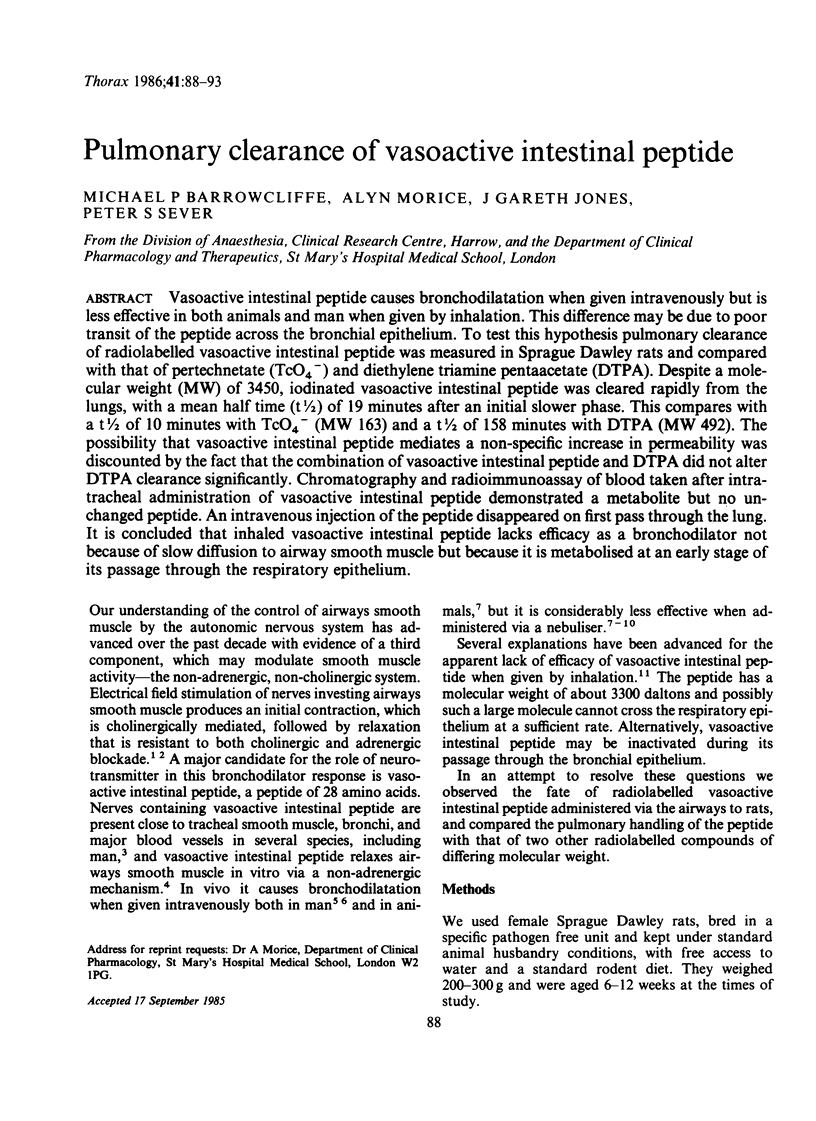
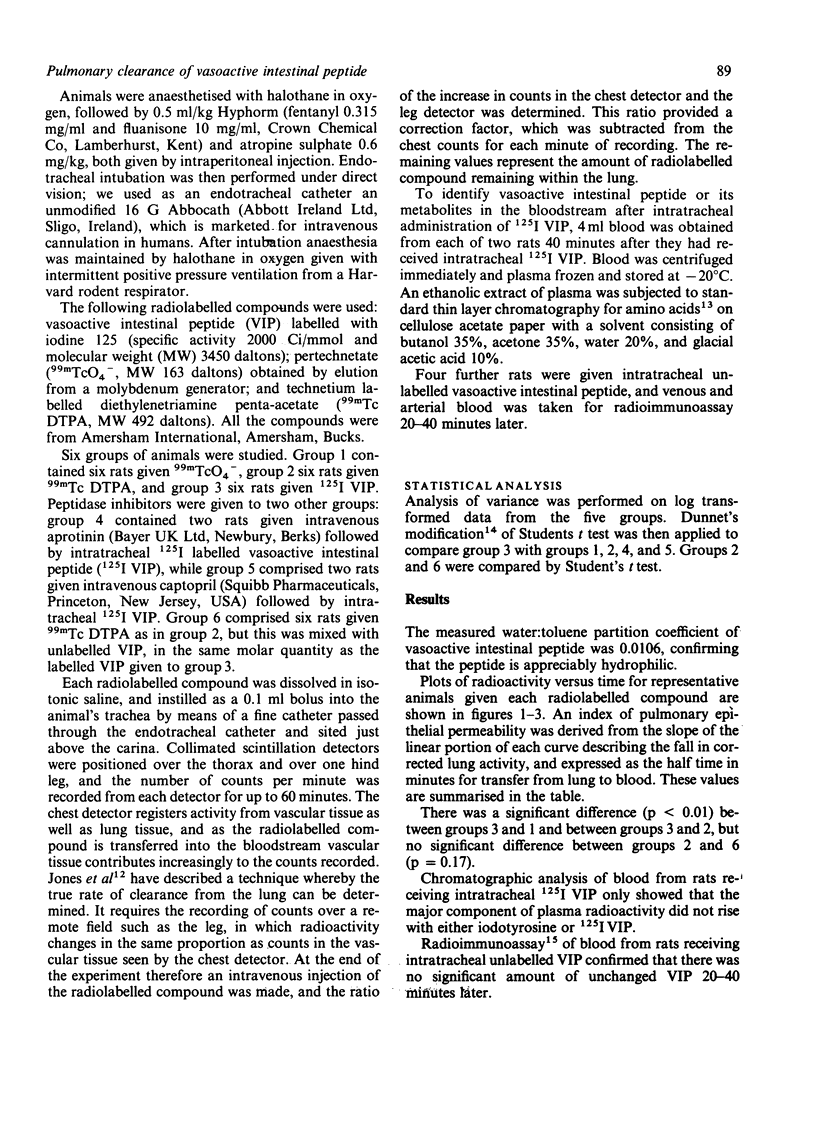
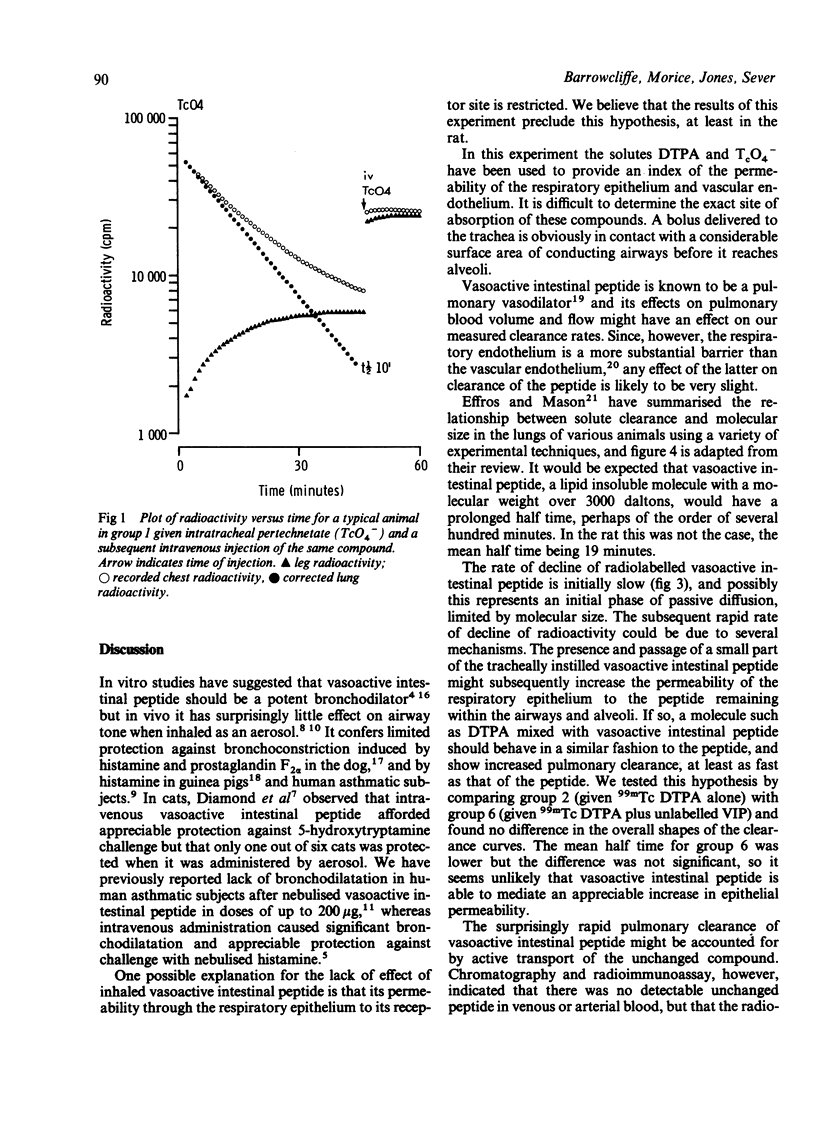
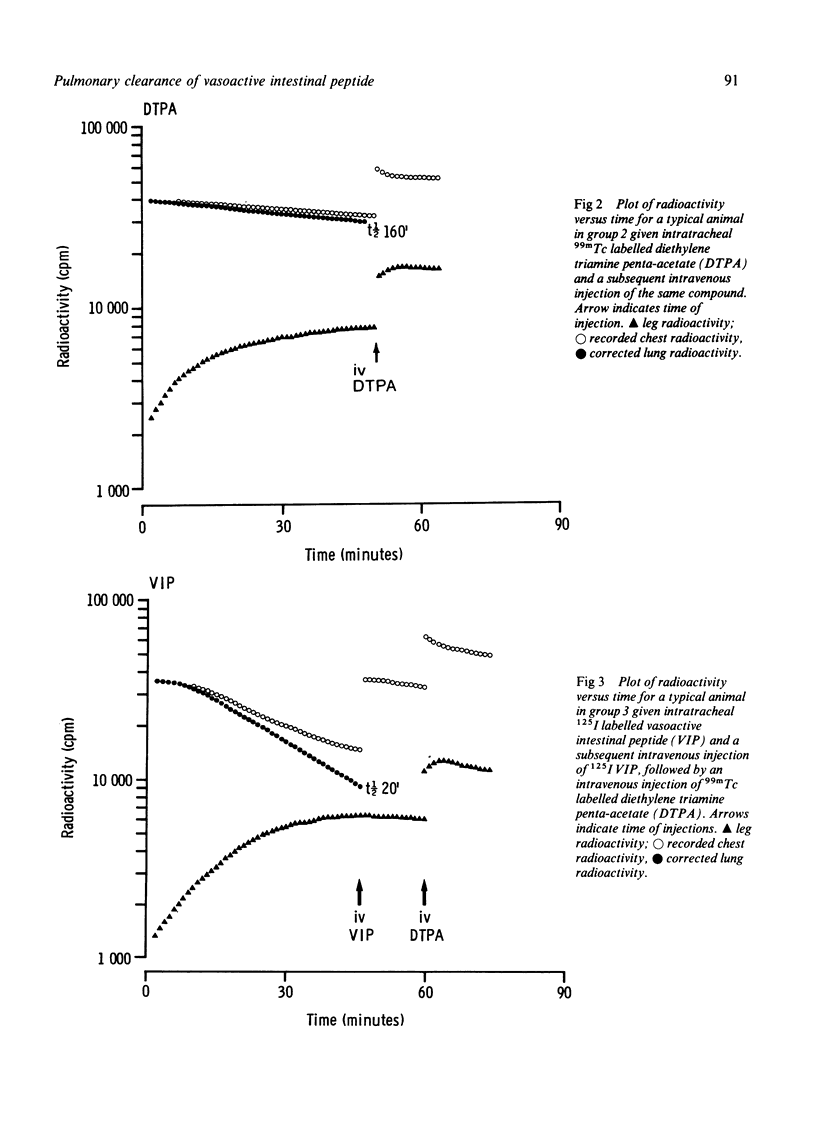
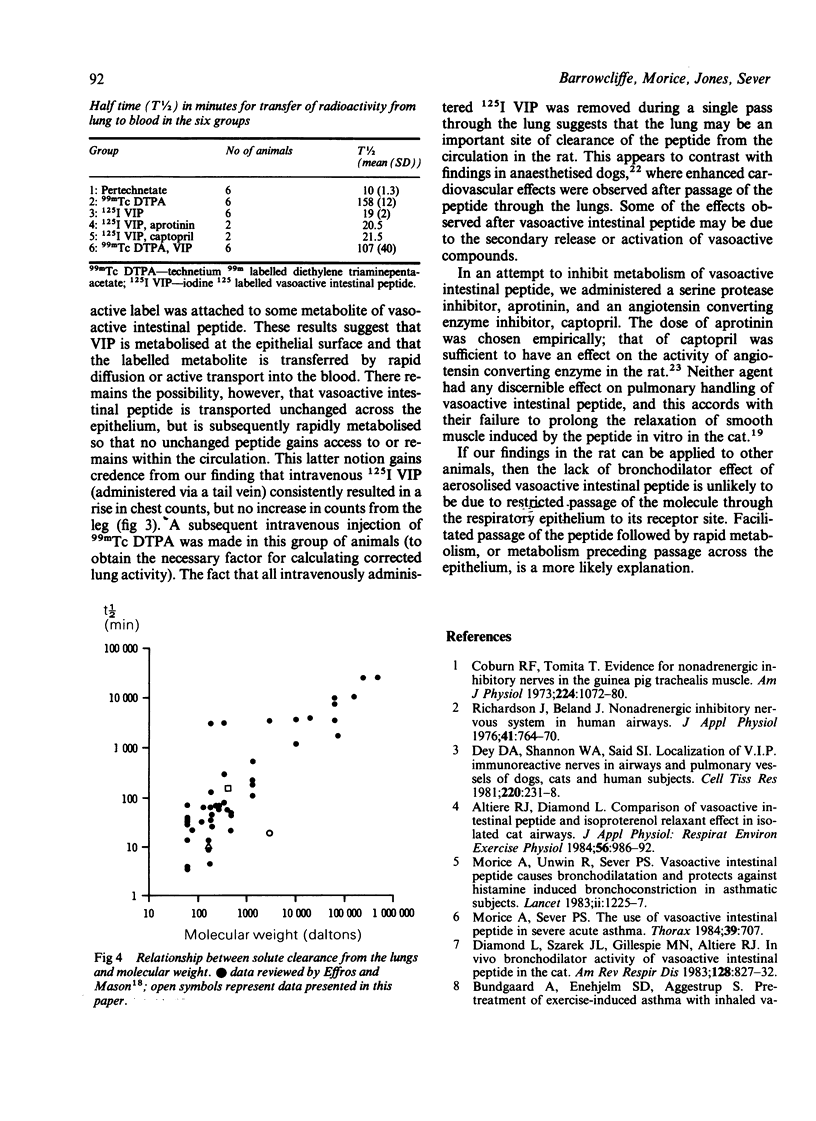
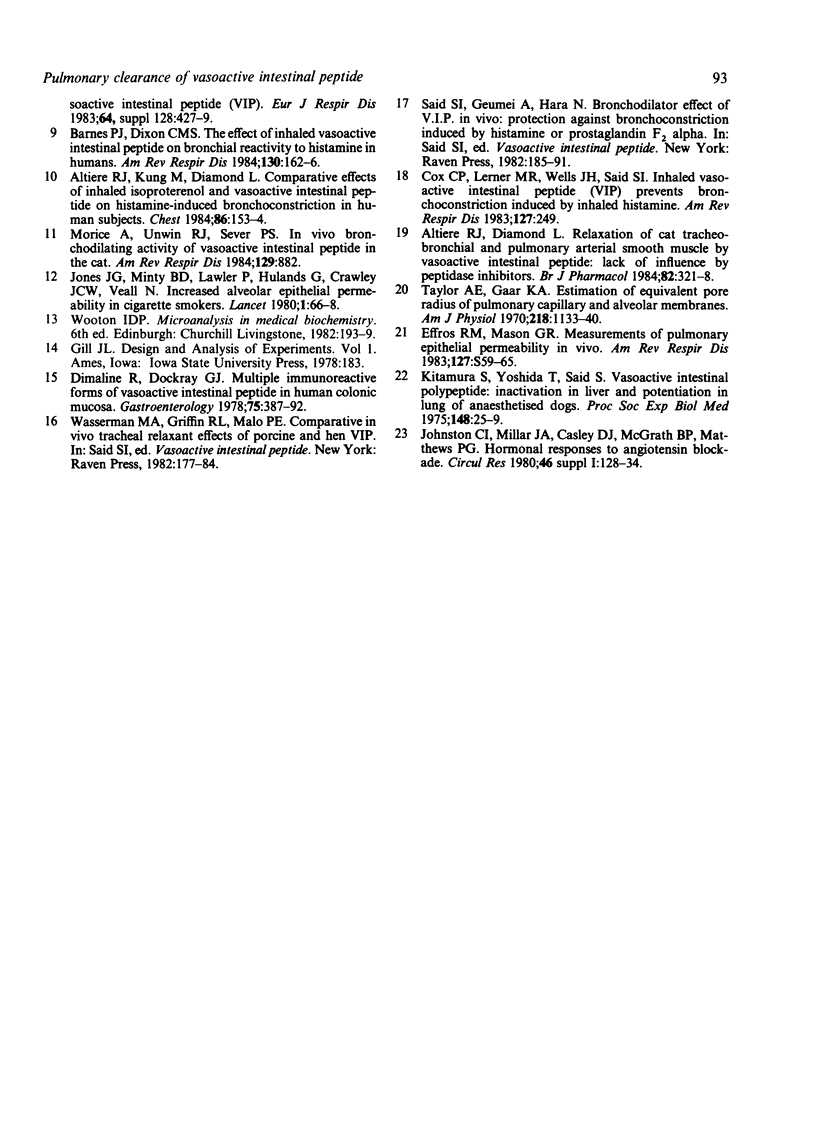
Selected References
These references are in PubMed. This may not be the complete list of references from this article.
- Altiere R. J., Diamond L. Comparison of vasoactive intestinal peptide and isoproterenol relaxant effects in isolated cat airways. J Appl Physiol Respir Environ Exerc Physiol. 1984 Apr;56(4):986–992. doi: 10.1152/jappl.1984.56.4.986. [DOI] [PubMed] [Google Scholar]
- Altiere R. J., Diamond L. Relaxation of cat tracheobronchial and pulmonary arterial smooth muscle by vasoactive intestinal peptide: lack of influence by peptidase inhibitors. Br J Pharmacol. 1984 Jun;82(2):321–328. doi: 10.1111/j.1476-5381.1984.tb10766.x. [DOI] [PMC free article] [PubMed] [Google Scholar]
- Altiere R. J., Küng M., Diamond L. Comparative effects of inhaled isoproterenol and vasoactive intestinal peptide on histamine-induced bronchoconstriction in human subjects. Chest. 1984 Jul;86(1):153–154. doi: 10.1378/chest.86.1.153. [DOI] [PubMed] [Google Scholar]
- Barnes P. J., Dixon C. M. The effect of inhaled vasoactive intestinal peptide on bronchial reactivity to histamine in humans. Am Rev Respir Dis. 1984 Aug;130(2):162–166. doi: 10.1164/arrd.1984.130.2.162. [DOI] [PubMed] [Google Scholar]
- Coburn R. F., Tomita T. Evidence for nonadrenergic inhibitory nerves in the guinea pig trachealis muscle. Am J Physiol. 1973 May;224(5):1072–1080. doi: 10.1152/ajplegacy.1973.224.5.1072. [DOI] [PubMed] [Google Scholar]
- Dey R. D., Shannon W. A., Jr, Said S. I. Localization of VIP-immunoreactive nerves in airways and pulmonary vessels of dogs, cat, and human subjects. Cell Tissue Res. 1981;220(2):231–238. doi: 10.1007/BF00210505. [DOI] [PubMed] [Google Scholar]
- Diamond L., Szarek J. L., Gillespie M. N., Altiere R. J. In vivo bronchodilator activity of vasoactive intestinal peptide in the cat. Am Rev Respir Dis. 1983 Nov;128(5):827–832. doi: 10.1164/arrd.1983.128.5.827. [DOI] [PubMed] [Google Scholar]
- Dimaline R., Dockray G. J. Multiple immunoreactive forms of vasoactive intestinal peptide in human colonic mucosa. Gastroenterology. 1978 Sep;75(3):387–392. [PubMed] [Google Scholar]
- Effros R. M., Mason G. R. Measurements of pulmonary epithelial permeability in vivo. Am Rev Respir Dis. 1983 May;127(5 Pt 2):S59–S65. [PubMed] [Google Scholar]
- Jones J. G., Minty B. D., Lawler P., Hulands G., Crawley J. C., Veall N. Increased alveolar epithelial permeability in cigarette smokers. Lancet. 1980 Jan 12;1(8159):66–68. doi: 10.1016/s0140-6736(80)90493-6. [DOI] [PubMed] [Google Scholar]
- Kitamura S., Yoshida T., Said S. I. Vasoactive intestinal polypoptide: inactivation in liver and potentiation in lung of anesthetized dogs (384699). Proc Soc Exp Biol Med. 1975 Jan;148(1):25–29. doi: 10.3181/00379727-148-38469. [DOI] [PubMed] [Google Scholar]
- Morice A., Unwin R. J., Sever P. S. Vasoactive intestinal peptide causes bronchodilatation and protects against histamine-induced bronchoconstriction in asthmatic subjects. Lancet. 1983 Nov 26;2(8361):1225–1227. doi: 10.1016/s0140-6736(83)91272-2. [DOI] [PubMed] [Google Scholar]
- Richardson J., Béland J. Nonadrenergic inhibitory nervous system in human airways. J Appl Physiol. 1976 Nov;41(5 Pt 1):764–771. doi: 10.1152/jappl.1976.41.5.764. [DOI] [PubMed] [Google Scholar]
- Taylor A. E., Gaar K. A., Jr Estimation of equivalent pore radii of pulmonary capillary and alveolar membranes. Am J Physiol. 1970 Apr;218(4):1133–1140. doi: 10.1152/ajplegacy.1970.218.4.1133. [DOI] [PubMed] [Google Scholar]


